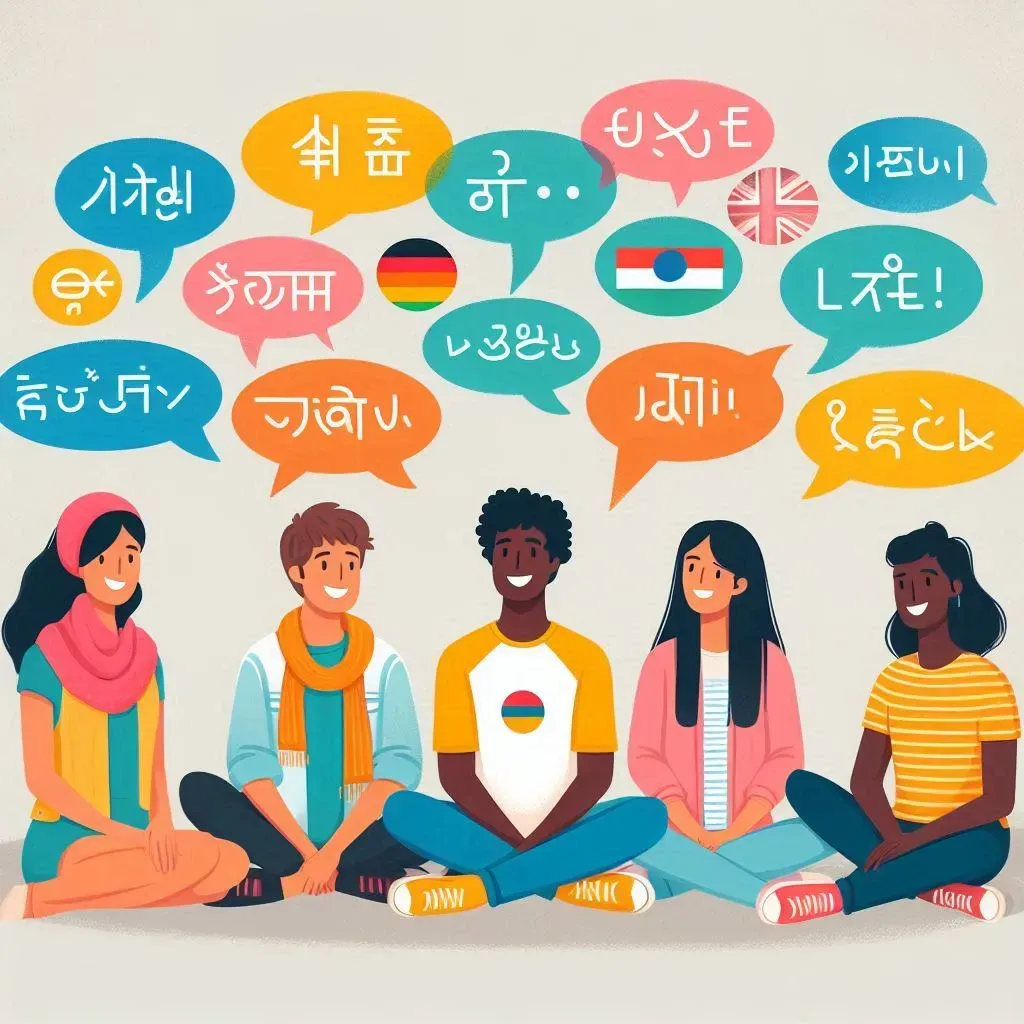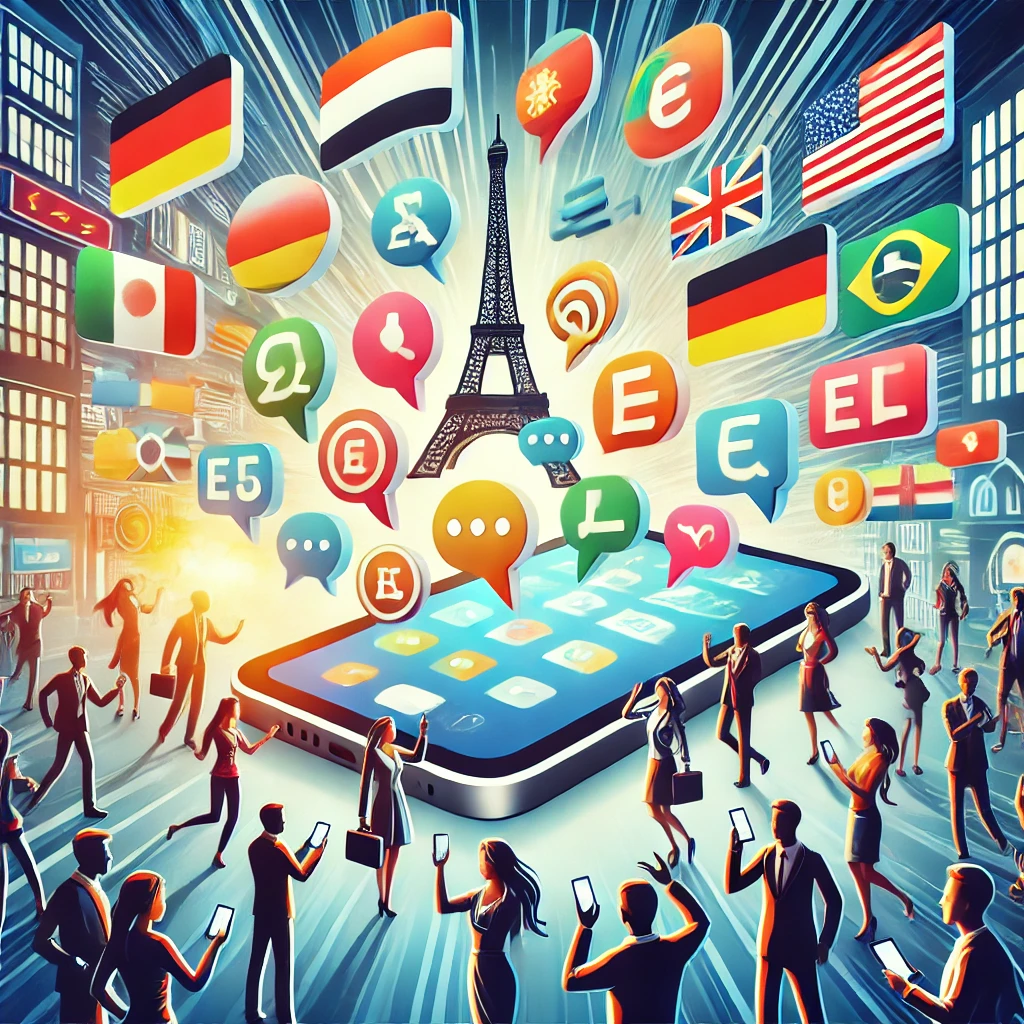- Twisted Tea: The Ultimate 2025 Guide(Kept up to date) - 08/13/2025
- 100 Best Eat & Drink Ultimate 2025 Global List - 08/11/2025
- Top 10 Celsius Drink: The Ultimate 2025 Guide - 08/07/2025

Table of Contents
Best App to Learn a Language: Top Picks for Every Learner
In an increasingly globalized world, learning a new language has never been more essential. Whether for travel, work, or simply personal growth, mastering a foreign language is a valuable skill. Fortunately, technology has made it easier than ever with various language-learning apps available at your fingertips. These apps range from fun, gamified experiences to immersive learning methods. In this article, we’ll explore the best language-learning apps and what sets each apart, helping you decide which app suits your learning style and goals.
1. Duolingo: Fun and Gamified Learning
Duolingo is perhaps the most recognized language-learning app, and it’s easy to see why. The app turns language learning into a game with short, engaging lessons that feel more like playing than studying. With its user-friendly interface and gamified system, learners can earn points, unlock levels, and maintain streaks for consistent practice. Duolingo offers courses in over 30 languages, from widely spoken options like Spanish and French to lesser-known languages like Hawaiian and Welsh.
Why It’s Great:
- Gamification: The app uses rewards, levels, and daily goals to keep users motivated.
- Short, Digestible Lessons: Lessons are designed to take just a few minutes, perfect for on-the-go learning.
- Free to Use: Duolingo offers a robust free version, making it accessible to a wide audience.
However, Duolingo’s approach is often criticized for its lack of in-depth grammar explanations and conversational practice. It’s best suited for beginners or casual learners looking to expand their vocabulary and grasp basic sentence structures.
2. Babbel: Structured Learning for Real-World Conversations
Babbel takes a more traditional approach to language learning, with lessons designed by linguistic experts. Unlike Duolingo, Babbel focuses on helping users quickly build practical language skills for real-world conversations. Each lesson is structured to improve grammar, vocabulary, and pronunciation in a logical sequence, ensuring that learners gain a well-rounded understanding of their target language.
Why It’s Great:
- Comprehensive and Structured Lessons: Lessons are progressive, covering grammar and sentence structure, which helps users build a strong foundation.
- Real-Life Conversations: Babbel emphasizes dialogue-based learning, which helps users prepare for real-world situations.
- Multiple Languages: The app offers courses in 14 languages, including popular options like German, Spanish, and Italian.
One downside is that Babbel is a paid app, with only a limited number of free lessons available. However, for learners looking for in-depth instruction, the cost is worth it.
3. Rosetta Stone: Immersive Language Learning
Rosetta Stone is a pioneer in the language-learning industry and offers a unique immersion approach. The app teaches languages without relying on translations, encouraging users to associate words directly with images and contexts. This “dynamic immersion” helps learners think in their target language and develop a natural understanding over time.
Why It’s Great:
- Immersive Learning: The app avoids direct translation, promoting a deeper understanding of the language.
- Speech Recognition Technology: Rosetta Stone’s speech recognition tool helps learners improve pronunciation by providing real-time feedback.
- Cross-Platform Learning: The app can be accessed on both mobile devices and desktops, making it versatile and accessible.
The only significant drawback is its price, as Rosetta Stone tends to be more expensive than other language apps. However, its immersion-based method is ideal for those who want a deep, intuitive learning experience.
4. Memrise: Fun Learning with Native Speakers
Memrise takes a more interactive and contextual approach to language learning. The app features user-generated content and mnemonic techniques to help learners remember new words and phrases. Memrise stands out for its use of video clips featuring native speakers, allowing learners to hear authentic accents and regional dialects.
Why It’s Great:
- Real-Life Video Content: Memrise incorporates videos of native speakers to demonstrate how words and phrases are used in real-life contexts.
- Engaging Learning Techniques: The app uses mnemonic devices and repetition to help users retain vocabulary more effectively.
- Wide Variety of Languages: Memrise offers courses in over 16 languages, including Japanese, Arabic, and Russian.
While Memrise is excellent for learning vocabulary and pronunciation, it may not provide the depth in grammar or writing that some learners need, making it better for casual learners or those supplementing other methods.
5. Busuu: Learning with Native Speakers and AI Support
Busuu offers a balanced language-learning experience, blending structured lessons with community support from native speakers. One of the app’s most significant features is the ability to get feedback on your written and spoken exercises from native speakers, adding a social learning element. Additionally, Busuu uses artificial intelligence to create personalized study plans based on your progress and goals.
Why It’s Great:
- Native Speaker Interaction: Users can connect with native speakers who provide feedback on writing and speaking exercises.
- Personalized Learning Plans: Busuu tailors lessons to each individual based on their skill level and learning preferences.
- McGraw-Hill Certifications: Users can earn official certificates upon completing certain language levels, which can be a great addition to a resume.
Busuu’s free version is limited, and to access features like offline mode and more personalized feedback, users will need to subscribe to the premium plan.
6. Pimsleur: Audio-Focused Learning on the Go
Pimsleur is perfect for learners who prefer audio-based lessons. Its method is designed to teach languages through conversation, making it a great tool for those who want to practice speaking and listening. The app’s lessons are designed to be listened to on the go, which is particularly useful for commuters or auditory learners.
Why It’s Great:
- Audio-Centric: The app focuses on listening and repeating, making it a great option for practicing conversational skills.
- Hands-Free Learning: Since lessons are audio-based, users can learn while commuting, exercising, or doing other tasks.
- Practical Conversations: Lessons are designed to teach conversational phrases for everyday situations.
However, Pimsleur does not emphasize reading or writing, so it may not be ideal for those looking for a comprehensive language-learning tool. It’s best suited for those who want to develop their conversational skills quickly.

Conclusion: Choosing the Best App for You
The best app for learning a language ultimately depends on your personal preferences, learning style, and goals. Duolingo is a great choice for beginners and casual learners, while Babbel and Busuu are better for those seeking structured lessons and conversational practice. Rosetta Stone and Pimsleur offer immersive and audio-based approaches, respectively, for learners who want something different. By choosing the right app and staying consistent, you can make significant progress toward fluency in your desired language.
- How to Be Funny Ultimate 2025 Guide
- 100 Best Guess What Jokes Ultimate 2025 Guide
- What the Difference Between Jokes? 2025 In-Depth
- What Is a Homemaker? 2025 Expert-Backed Guide
- 100 Best Dad Jokes for Kids 2025 Ultimate Guide
- 100 Best Bad Dad Jokes 2025 Ultimate Guide
- 100 Best Deez Nuts Joke 2025 Ultimate Guide
- 100 Best Candice Joke 2025 In-Depth Guide
- Top 100 Best Christmas Movies 2025 In-Depth Guide
- Top 100 Best Christmas Family Games 2025
- Top 100 Best Fun Family Games 2025 In-Depth Guide
- Top 100 Best Family Games 2025 Ultimate Guide
- 100 Talk Show Hosts 2025 In-Depth Guide
- 100 Best Funny Dad Jokes 2025 In-Depth Guide
- 100 Best Funny Games 2025 In-Depth Guide
- 100 Best Funny Names 2025 In-Depth Guide
- 100 Best Good Jokes 2025 In-Depth Guide
- 100 Best Christmas Jokes 2025 🎅 In-Depth Guide
- 100 Best Corny Jokes 2025 In-Depth Guide
- 100 Best Kids Jokes 2025 In-Depth Guide
- 100 Best Knock Knock Jokes 2025 In-Depth Guide
- 100 Best Dark Jokes 2025 😈 | In-Depth & Hilarious Guide
- 100 Best Dark Humor Jokes 2025 In-Depth Guide
- 100 Attractions in the World 2025 In-Depth Guide
- Amazon Best Sellers in Clothing Shoes: Top 10 2025
- Walmart Photo Center: The Ultimate Guide 2025
- Capybara as a Pet: The Ultimate Guide 2025
- Top 100 Attractions in the World 2025
- US Female Movie Stars Top 10 2025 In-Depth Guide
- Who is the Most Handsome Man in the World?
- Top 100 Party Entertainment Ideas 2025
- 100 Best Dad Jokes That Never Get Old 2025
- US Male Movie Stars Top 10
- How to Make Slime 2025 In-Depth Guide
- YouTube History Top 10 Funny Videos 2025 In-Depth
- How to Make a Paper Airplane 2025 In-Depth Guide
- Can Dogs Eat Fruit? A Comprehensive Guide 2025
- The Funniest Dad Jokes 2025 In-Depth Guide
- 100 Funny Jokes 2025 In-Depth Guide
- 2025 100 Best Dad Jokes In-Depth Guide
- Best Dry Humor 2025 In-Depth Guide
- Calico Cat Names: 2025 Ultimate Guide
- Why Are Dogs So Cute? In-Depth Guide 2025
- Can Dogs Eat Tomatoes? A Complete Guide for Pet Owners
- What Can Dogs Eat? 2025 A Complete Guide
- Why Are Cats So Cute 2025
- Can Dogs Eat Cat Food 2025 In-Depth Guide
- Why Does My Cat Lick Me 2025
- 999 Angel Number Meaning: A Complete Guide
- 888 Angel Number Meaning: A Powerful Symbol
- 666 Angel Number Meaning: Hidden Meaning
- Meaning of 555 in Love: Spiritual and Symbolic Messages
- 333 Angel Number Meaning: A Spiritual Guide
- 222 Angel Number Meaning: A Comprehensive Guide
- 777 Angel Number Meaning: A Comprehensive Guide
- 444 Angel Number Meaning: A Comprehensive Guide
- 111 Angel Number Meaning: A Comprehensive Guide
- Best Ginger Cat Names(25 Types Perfect Choice)
- What is the Krabby Patty Secret Formula? 2025 Deep Dive
- Best SpongeBob Party(1 Complete Guide)
- The Lovable Villain of SpongeBob: Plankton
- SpongeBob SquarePants(Character Design and Voice Actor)
- SpongeBob SquarePants: Iconic Character Introductions
- Classic SpongeBob SquarePants Episodes and Quotes
- SpongeBob SquarePants: All Character Introductions
- SpongeBob Meme: The Phenomenon Explained
- Toy Poodle: The Perfect Petite Companion
Amazon Best Sellers in Health & Household: Top 10 Must-Have Products for Every Household
We all want a cleaner, healthier home - but who has time to sort through Amazon's endless options? The good news: millions of shoppers have already done the work for you by voting with their wallets.
These Health & Household bestsellers aren't just popular - they're the real MVPs that:
• Make everyday tasks easier
• Deliver quality without the crazy price tag
• Earn rave reviews again and again
From bathroom upgrades to cleaning must-haves, here are the 10 products worth adding to your cart today:
1. Bounty Quick Size Paper Towels, White, 8 Family Rolls = 20 Regular Rolls (Packaging May Vary)
Product Overview: When it comes to cleaning up spills and messes, few brands are as trusted as Bounty. Known for their durability and absorbency, Bounty Quick Size Paper Towels offer high-quality performance with the convenience of quick and easy cleanup. With this pack of 8 Family Rolls, you get the equivalent of 20 regular rolls, making it a cost-effective solution for your home.
Key Features:
- Extra-absorbent for faster cleanup.
- Quick Size sheets to help reduce waste.
- Ideal for both small and large messes.
- Soft yet durable for everyday use.
Customer Benefits: Bounty’s Quick Size Paper Towels are designed to tackle even the toughest spills. Whether you're cleaning up water, grease, or food messes, these towels can handle it all. Plus, the compact roll size is perfect for storing in tight spaces, and the generous pack size ensures you won’t run out too soon.
2. Amazon Basics 2-Ply Toilet Paper, 30 Rolls = 120 Regular Rolls, 350 Sheets, Unscented
Product Overview: Looking for a reliable toilet paper option that combines both comfort and value? Amazon Basics offers a 2-ply toilet paper that’s perfect for households of all sizes. With 30 rolls in this pack, you’re getting the equivalent of 120 regular rolls, each containing 350 sheets. Plus, the unscented version ensures it’s suitable for sensitive skin.
Key Features:
- 2-ply sheets for softness and strength.
- 350 sheets per roll for extended use.
- Unscented and hypoallergenic for sensitive skin.
- High absorbency to minimize usage.
Customer Benefits: This toilet paper delivers superior quality without the high price tag. The soft, yet durable sheets make it ideal for everyday use, and the large pack size means you’ll be stocked up for a while, saving you the hassle of frequent reordering.
3. LMNT Zero Sugar Electrolytes - Variety Pack | Drink Mix | 12-Count
Product Overview: For those looking to stay hydrated and replenish lost electrolytes, LMNT Zero Sugar Electrolytes are an excellent choice. This variety pack offers 12 individual servings of drink mix, providing a refreshing and healthy alternative to sugary sports drinks. Each serving is packed with electrolytes and contains zero sugar, making it a great option for fitness enthusiasts and health-conscious individuals.
Key Features:
- Zero sugar and no artificial ingredients.
- Packed with electrolytes to maintain hydration.
- Available in a variety pack with different flavors.
- Suitable for all ages, including athletes.
Customer Benefits: LMNT Electrolytes help you stay hydrated and maintain optimal body function, whether you're hitting the gym or just staying active throughout the day. The convenient packets make it easy to take on the go, and the variety of flavors ensures there's something for everyone.
4. Charmin Ultra Soft Cushiony Touch Toilet Paper, 24 Family Mega Rolls = 123 Regular Rolls
Product Overview: Charmin Ultra Soft Toilet Paper is known for its incredible softness and comfort. With 24 Family Mega Rolls that equate to 123 regular rolls, this toilet paper provides excellent value. The ultra-soft texture ensures a luxurious experience every time you use it, making it perfect for those who prioritize comfort.
Key Features:
- Ultra-soft for maximum comfort.
- Mega rolls last longer than standard rolls.
- 2-ply for strength and durability.
- Ideal for large households or frequent use.
Customer Benefits: Charmin Ultra Soft Toilet Paper is perfect for those who want a high-quality, soft experience without compromising on strength. The long-lasting mega rolls reduce the frequency of replenishing your supply, saving you time and effort in the long run.
5. Scott ComfortPlus Toilet Paper, 12 Double Rolls, 231 Sheets per Roll, Septic-Safe, 1-Ply Toilet Tissue
Product Overview: Scott ComfortPlus Toilet Paper offers an affordable and reliable option for everyday use. With 12 double rolls, each containing 231 sheets, this toilet paper provides excellent value while maintaining strength and softness. It’s septic-safe, making it a great choice for homes with septic systems.
Key Features:
- 1-ply design for efficiency and strength.
- Septic-safe for homes with septic systems.
- 231 sheets per roll for more use.
- Affordable and budget-friendly.
Customer Benefits: Scott ComfortPlus Toilet Paper is perfect for those who need a reliable, affordable toilet paper that performs well and doesn’t clog septic systems. It’s a great choice for families or those with a high household demand.
6. Hefty Ultra Strong Tall Kitchen Trash Bags, Lavender & Sweet Vanilla Scent, 13 Gallon, 80 Count
Product Overview: Hefty Ultra Strong Tall Kitchen Trash Bags provide extra strength for your kitchen cleanup needs. These 13-gallon bags are ideal for large households or those who generate significant waste. The lavender and sweet vanilla scent ensures that your kitchen stays smelling fresh while these bags handle even the heaviest loads.
Key Features:
- Ultra-strong to handle heavy loads without breaking.
- 13-gallon size fits most kitchen bins.
- Scented with lavender and sweet vanilla for freshness.
- 80-count package for long-term use.
Customer Benefits: These trash bags are designed to make your kitchen clean-up quick and easy. The scented bags help mask odors, and their durability ensures they won’t tear or break under pressure. With 80 bags in a pack, they’re a great value for any home.
7. Sparkle Pick-A-Size Paper Towels, 6 Double Rolls = 12 Regular Rolls, Everyday Value Paper Towel With Full And Half Sheets
Product Overview: Sparkle Pick-A-Size Paper Towels are perfect for households looking for versatile, durable, and affordable paper towels. With the ability to choose between full or half sheets, these towels give you flexibility when it comes to cleaning up messes of any size. This 6 double-roll pack is equivalent to 12 regular rolls, providing great value.
Key Features:
- Pick-A-Size design to save on waste.
- Strong and absorbent for everyday messes.
- Available in a value pack of 6 double rolls.
- Soft enough for most cleaning tasks.
Customer Benefits: Sparkle’s Pick-A-Size Paper Towels are a great choice for anyone who wants to minimize waste while maximizing the cleaning power. The absorbent material is perfect for cleaning up both small and large messes around the house.
8. Miss Mouth's Messy Eater Stain Treater Spray - 4oz Stain Remover
Product Overview: Miss Mouth's Messy Eater Stain Treater Spray is a must-have for parents of young children or anyone who deals with frequent stains. This 4oz spray is specifically designed to remove food, grease, and coffee stains from fabrics without requiring dry cleaning. It’s perfect for treating stubborn stains on clothes, upholstery, and even undergarments.
Key Features:
- Removes food, grease, coffee, and other tough stains.
- Safe for use on a variety of fabrics.
- Non-toxic and environmentally friendly.
- Ideal for busy parents and families.
Customer Benefits: This stain treater is a lifesaver for busy families or anyone who is constantly dealing with food or beverage stains. It works quickly and effectively, helping to restore fabrics without any harsh chemicals or complicated processes.
9. Physician's Choice Probiotics 60 Billion CFU - 10 Strains + Organic Prebiotics - Immune, Digestive & Gut Health
Product Overview: Physician's Choice Probiotics is a premium product designed to support gut health, digestion, and overall immunity. With 60 billion CFU per capsule and 10 probiotic strains, it’s an effective supplement for anyone looking to improve their digestive health and strengthen their immune system.
Key Features:
- 60 billion CFU per serving for maximum potency.
- Includes 10 probiotic strains and organic prebiotics.
- Supports digestive health, immunity, and gut balance.
- Ideal for both men and women.
Customer Benefits: Physician's Choice Probiotics is a great addition to any health regimen, particularly for those dealing with digestive issues. It helps maintain a healthy gut microbiome, improve digestion, and support overall well-being.
10. Cottonelle Fresh Feel Flushable Wet Wipes, Adult Wet Wipes, 8 Flip-Top Packs, 42 Wipes Per Pack
Product Overview: For added freshness and hygiene, Cottonelle Fresh Feel Flushable Wet Wipes are a great companion to regular toilet paper. These wipes are designed for adults and come in a convenient 8-pack with 42 wipes per pack, ensuring you always have access to a clean, refreshing experience.
Key Features:
- Flushable and septic-safe for easy disposal.
- Soft and gentle on skin.
- Ideal for use after toilet paper for a fresher clean.
- 8-pack for long-lasting supply.
Customer Benefits: These wet wipes add an extra layer of freshness after using the restroom, making them perfect for anyone who wants to feel cleaner and more refreshed. The flushable design ensures easy disposal, while the soft material is gentle on the skin.
Let's be real - these bestsellers became popular for good reason. We're talking:
• Everyday essentials that actually work (no more flimsy paper towels!)
• Health boosters your body will thank you for
• All the little things that make home life smoother
Add a few to your next order and feel the difference - your future self will appreciate the upgrade.
🎯 Don’t Miss Out — These Are Reader-Favorite Bestsellers You’ll Love Too 👇
| # | 🎁 Product | 💬 Why It Converts | 🔗 Quick Action |
|---|---|---|---|
| ✅ 1 | Exploding KittensThe Wildly Popular Card Game | 🔥 100,000+ rave reviews🤣 Fun for all ages🎉 #1 party game choice | 👉 Click to Check Price |
| 😂 2 | Funny Dad T-Shirt“You Can’t Scare Me, I Have Kids” | 👕 Viral dad gift🎂 Perfect for birthdays & Father’s Day💬 Gets people laughing instantly | 👉 See It in Action |
| 🕯️ 3 | Luxury Candle Gift SetElegant 1-Wick, Spa Fragrance | 🧘♀️ Instant relaxation🎁 Beautifully boxed for gifting💡 Affordable luxury | 👉 Treat Yourself or Gift Now |
| 🔍 4 | Tile Bluetooth TrackerFind Anything in Seconds | 🛠️ Life-saving tech🧓 Great for parents, teens, travelers📱 Works with your phone | 👉 Never Lose Anything Again |
| 📘 5 | Atomic Habits by James ClearTransform Your Daily Life | 📖 20M+ readers worldwide🔑 Simple steps, big results🎓 Top self-growth book | 👉 Read What Everyone’s Talking About |
✅ Why These Items Sell:
| 💡 Trigger | Example in Table | How It Helps Conversion |
|---|---|---|
| ✅ Social Proof | “100,000+ rave reviews” | Builds trust instantly |
| 🎯 Use Case Clarity | “Great for family game night” | Reduces decision friction |
| 🚀 Action Verbs | “Click to check price” | Encourages immediate action |
| 🔥 Urgency & Emotion | “Don’t miss out” / “Treat yourself” | Triggers impulse buying |
| 🎁 Gifting Potential | “Perfect for birthdays & holidays” | Taps into universal purchase intent |
❤️ Your Click Makes a Difference
Every purchase made through these links helps support this site and keeps great content coming — Thanks!
💬 Why Tip? It’s Not Just Money — It’s Motivation ❤️
| 😊 What You Got | 🎁 What I Get | 🔗 What You Can Do |
|---|---|---|
| ✔️ A smile or laugh | ✔️ A reason to keep creating | 👉 Buy me a coffee ☕️ |
| ✔️ Useful tips, insights, or ideas | ✔️ Proof that this content helps | 👉 Click the support button 💸 |
| ✔️ Fun, relatable content | ✔️ Motivation to go deeper & better | 👉 Leave a tip + kind feedback 🙌 |
| ✔️ Ad-free reading experience | ✔️ A little financial breathing room | 👉 $1 isn’t too little, $10 isn’t too much 🎉 |
| ✔️ A sense of connection | ✔️ The joy of being seen and supported | 👉 Let me know you’re out there 👀 |
❤️ If you made it this far, maybe that’s your sign to support? Every tip matters!




































































